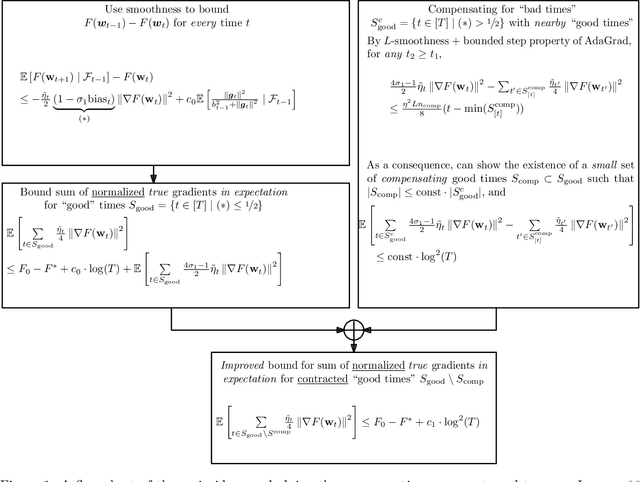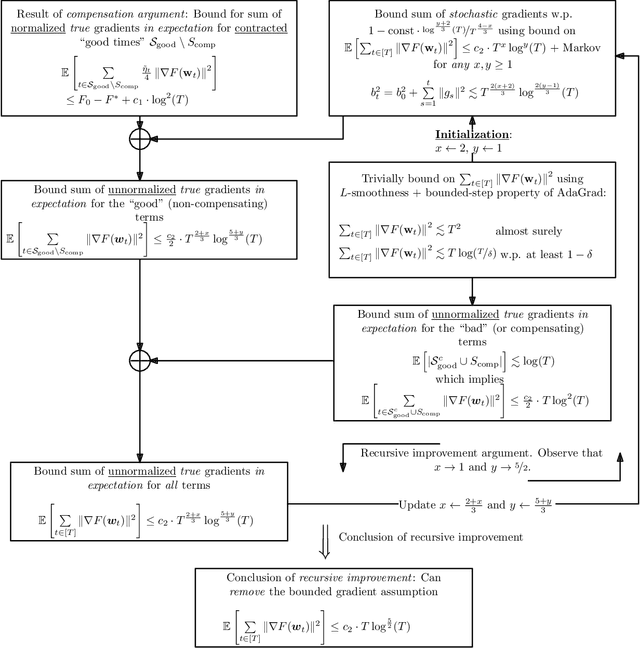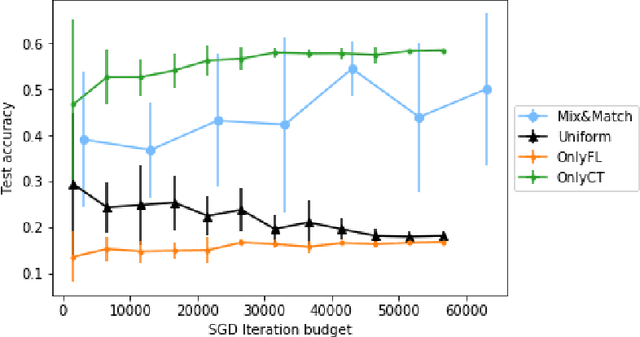Matthew Faw
On Mitigating Affinity Bias through Bandits with Evolving Biased Feedback
Mar 07, 2025



Abstract:Unconscious bias has been shown to influence how we assess our peers, with consequences for hiring, promotions and admissions. In this work, we focus on affinity bias, the component of unconscious bias which leads us to prefer people who are similar to us, despite no deliberate intention of favoritism. In a world where the people hired today become part of the hiring committee of tomorrow, we are particularly interested in understanding (and mitigating) how affinity bias affects this feedback loop. This problem has two distinctive features: 1) we only observe the biased value of a candidate, but we want to optimize with respect to their real value 2) the bias towards a candidate with a specific set of traits depends on the fraction of people in the hiring committee with the same set of traits. We introduce a new bandits variant that exhibits those two features, which we call affinity bandits. Unsurprisingly, classical algorithms such as UCB often fail to identify the best arm in this setting. We prove a new instance-dependent regret lower bound, which is larger than that in the standard bandit setting by a multiplicative function of $K$. Since we treat rewards that are time-varying and dependent on the policy's past actions, deriving this lower bound requires developing proof techniques beyond the standard bandit techniques. Finally, we design an elimination-style algorithm which nearly matches this regret, despite never observing the real rewards.
In-Context Fine-Tuning for Time-Series Foundation Models
Oct 31, 2024



Abstract:Motivated by the recent success of time-series foundation models for zero-shot forecasting, we present a methodology for $\textit{in-context fine-tuning}$ of a time-series foundation model. In particular, we design a pretrained foundation model that can be prompted (at inference time) with multiple time-series examples, in order to forecast a target time-series into the future. Our foundation model is specifically trained to utilize examples from multiple related time-series in its context window (in addition to the history of the target time-series) to help it adapt to the specific distribution of the target domain at inference time. We show that such a foundation model that uses in-context examples at inference time can obtain much better performance on popular forecasting benchmarks compared to supervised deep learning methods, statistical models, as well as other time-series foundation models. Interestingly, our in-context fine-tuning approach even rivals the performance of a foundation model that is explicitly fine-tuned on the target domain.
Beyond Uniform Smoothness: A Stopped Analysis of Adaptive SGD
Feb 13, 2023Abstract:This work considers the problem of finding a first-order stationary point of a non-convex function with potentially unbounded smoothness constant using a stochastic gradient oracle. We focus on the class of $(L_0,L_1)$-smooth functions proposed by Zhang et al. (ICLR'20). Empirical evidence suggests that these functions more closely captures practical machine learning problems as compared to the pervasive $L_0$-smoothness. This class is rich enough to include highly non-smooth functions, such as $\exp(L_1 x)$ which is $(0,\mathcal{O}(L_1))$-smooth. Despite the richness, an emerging line of works achieves the $\widetilde{\mathcal{O}}(\frac{1}{\sqrt{T}})$ rate of convergence when the noise of the stochastic gradients is deterministically and uniformly bounded. This noise restriction is not required in the $L_0$-smooth setting, and in many practical settings is either not satisfied, or results in weaker convergence rates with respect to the noise scaling of the convergence rate. We develop a technique that allows us to prove $\mathcal{O}(\frac{\mathrm{poly}\log(T)}{\sqrt{T}})$ convergence rates for $(L_0,L_1)$-smooth functions without assuming uniform bounds on the noise support. The key innovation behind our results is a carefully constructed stopping time $\tau$ which is simultaneously "large" on average, yet also allows us to treat the adaptive step sizes before $\tau$ as (roughly) independent of the gradients. For general $(L_0,L_1)$-smooth functions, our analysis requires the mild restriction that the multiplicative noise parameter $\sigma_1 < 1$. For a broad subclass of $(L_0,L_1)$-smooth functions, our convergence rate continues to hold when $\sigma_1 \geq 1$. By contrast, we prove that many algorithms analyzed by prior works on $(L_0,L_1)$-smooth optimization diverge with constant probability even for smooth and strongly-convex functions when $\sigma_1 > 1$.
The Power of Adaptivity in SGD: Self-Tuning Step Sizes with Unbounded Gradients and Affine Variance
Feb 11, 2022


Abstract:We study convergence rates of AdaGrad-Norm as an exemplar of adaptive stochastic gradient methods (SGD), where the step sizes change based on observed stochastic gradients, for minimizing non-convex, smooth objectives. Despite their popularity, the analysis of adaptive SGD lags behind that of non adaptive methods in this setting. Specifically, all prior works rely on some subset of the following assumptions: (i) uniformly-bounded gradient norms, (ii) uniformly-bounded stochastic gradient variance (or even noise support), (iii) conditional independence between the step size and stochastic gradient. In this work, we show that AdaGrad-Norm exhibits an order optimal convergence rate of $\mathcal{O}\left(\frac{\mathrm{poly}\log(T)}{\sqrt{T}}\right)$ after $T$ iterations under the same assumptions as optimally-tuned non adaptive SGD (unbounded gradient norms and affine noise variance scaling), and crucially, without needing any tuning parameters. We thus establish that adaptive gradient methods exhibit order-optimal convergence in much broader regimes than previously understood.
Mix and Match: An Optimistic Tree-Search Approach for Learning Models from Mixture Distributions
Aug 23, 2019



Abstract:We consider a co-variate shift problem where one has access to several marginally different training datasets for the same learning problem and a small validation set which possibly differs from all the individual training distributions. This co-variate shift is caused, in part, due to unobserved features in the datasets. The objective, then, is to find the best mixture distribution over the training datasets (with only observed features) such that training a learning algorithm using this mixture has the best validation performance. Our proposed algorithm, ${\sf Mix\&Match}$, combines stochastic gradient descent (SGD) with optimistic tree search and model re-use (evolving partially trained models with samples from different mixture distributions) over the space of mixtures, for this task. We prove simple regret guarantees for our algorithm with respect to recovering the optimal mixture, given a total budget of SGD evaluations. Finally, we validate our algorithm on two real-world datasets.
 Add to Chrome
Add to Chrome Add to Firefox
Add to Firefox Add to Edge
Add to Edge